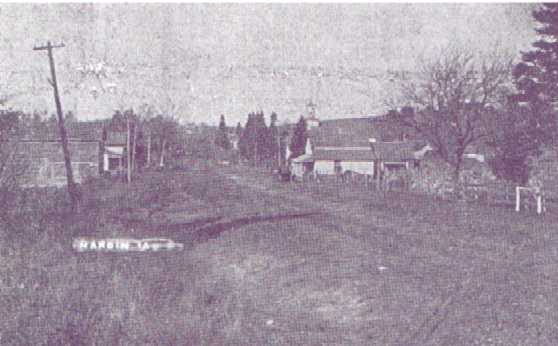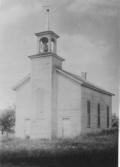![]()
Postville's Pioneer Neighbor
- Hardin -
Very few people today who speed along the graveled road for four miles going east of Postville, after leaving U.S. highways Nos. 52 and 18 at the south edge of town, are aware they they are approaching what was the most important trade center in northeast Iowa a little over a century ago. Coming to the old pioneer settlement of Hardin, Iowa from the west on [illegible] street, they very soon enter the main thoroughfare. Here, along this main street a few reminents of the past are left standing to remind the passer-by of the [illegible] days of long ago.

Hardin Main Street 1910
In those days, in addition to the [illegible] traffic through main street, scores of prairie schooners passed [illegible] almost daily to the north and west. The main trend of travel of [illegible] home-seeking immigrants from the east was from McGregor's Landing on the west bank of the Mississippi River across from Prairie du Chien to Decorah. It followed closely the old Indian trail between those two points. Hardin was about a day's travel from McGregor and afforded a night's lodging or a horse changing stop for the wayfarers.
Beginning in 1855 the shortest main overland stage line operating between St. Paul and Dubuque was [illegible] along this course. A means of transportation inland for passengers, mail and provisions was urgently needed for the rapidly growing town of St. Paul and the increasing numbers of pioneer farmers, which were completely isolated during the winter months while the Mississippi river was frozen over. This stage line was owned and operated by the M.O. Walker Stage Company of Chicago. This company had a four year (1854-1858) contract with the government to carry mail. Postmasters in Hardin during this period were Alonzo D. Frazier, 1854; Julius C. Beedy, 1857; Crawford Breedlove, 1858.
Stage fare from St. Paul to Dubuque in 1854 was $20. Agents described this travel accommodation as the fastest and most direct between the two cities. It took from four to five days to make the trip. A remarkable feat considering the forests, stumps, rocks, ditches and streams along the way. Walker boasted that passengers could attend church service in St. Paul one Sunday and in Dubuque the next.
Hardin was founded in 1849 by Leonard Bacon Hodges who came to this site and staked his claim in this valley just north of the Clayton county line. By fall of that year, through his influence, a school house had been built of oak logs on the hillside to the northwest -- the first schoolhouse built in Allamakee county. Hodges was the first teacher. The Hardin postoffice was established the following spring, March 11, 1850. Hodges was the first postmaster.
Samuel P. Hicks platted north Hardin n 1854. That same year he went with Mr. Hodges into Minnesota Territory in their pursuit to help blaze the trail to St. Paul and platted the little settlement called Oronoco. This little fading village 12 miles north of Rochester was also very important on the old St Paul-Dubuque Trail but has been by-passed long ago by the concrete highway U.S. 52.
Mr. Hodges was born in West Bloomfield, Mew York July 15, 1823. He was married to Miss Elizabeth Collins who died Jue 1851. Her tombstone still stands in the Hardin cemetery. He was the son of Lewis L. and Susan Bacon Hodges. His father was a physician and surgeon in the war of 1812. His mother was the daughter of the Rev. David and Alice Parks Bacon, missionaries to the Indian on Mackiac Island in 1801.
Co-founders of Hardin were Joseph Collins and Alonzo D. Fraizer, natives of Vermont and Ohio respectively.
Among the business and professional men in Hardin between 1856 and 1860 were Nathan Lamborn, W. Crawford Breedlove, Orlando Woodworth, Julius C. Beedy and Roger T. Burnham, who operated general stores; Robert Montgomery, Charles C. Hines, William H. Buttolph, William A. Stewart, and William H. Beaver, blacksmiths; Henry Barnhart, millwright; operators of grist mill and steam sawmill; Thomas C. Moore and William H. Dungan, harnessmakers; George W. Corning, carriage maker; Alfred Barnes, wheelwright; James O. Goddard, civil engineer; Drs. John S. Green and C.P. Sanford; hotel (or tavern) owned by Alonzo. D. and Cordelia Antonette Frazier, and later by Henry and Eliza Kramer Barnhart.
The photos above & below were restored & enlarged from small brownish photos by Allamakee researcher, Anita Von Ahsen. She believes they were taken in September 1861.The photos are annotated on the back "Hardin House" and "soldiers ready to leave"Above are the men with their mothers or wives, and below the soldiers with their fathers in the background. (More notes from Anita below)
Within the next decade attorneys S.S. Powers and T.C. Ransom located in Hardin. Horace S. Hunt and wife from Watertown, N.Y. operated a tailor shop. Mr. Dickerson was a storekeeper and a cabinet maker. Other business places were a jewelry store, a shoe shop where shoes were made, a photograph gallery, a shop where coffins were made to order, two millinery and dressmaking shops, and a saloon. R.T. Burnham operated a flour mill. Eugene Stewart manufactured brooms, and Duncan and Jane McDonald purchased the hotel.
At the present time a local farmer has a fanning mill that was manufactured in Hardin.
During these years more travel came in long lines of sleds or wagons from the north and west hauling increasing volumes of produce to McGregor. Thrifty pioneers sent their wheat, dressed hogs, lard, butter, hides and furs to the Landing on the Mississippi river to be shipped to eastern cities.

Hardin ME church 1907
- source of history & photo of main street in 1910: undated
article, compiled & written by Mrs. Leon Chamberlain, unknown
newspaper
- source of ME church photo: S. Ferrall, personal family photo.
- source of 1861 photos & notes: Anita Von Ahsen, personal family photos.
Anita adds the following historical information:
My ggg-grandparents, Joseph and Almira Whitman Collins, who with Leonard B Hodges had the land platted for the town. Leonard Hodges wife may have been Joseph's daughter, known in family records as Betsy as the tombstone states Elizabeth Collins, wife of Leonard (buried Hardin Cemetery). The tombstone states she died June 4, 1851; we have infamily records June 4, 1850, but that may have been an error. I would love to find out if this is the correct Betsy Collins, but I am not sure how. They married there Jan 13,1850. I don't think Joseph and Almira were there until 1850, but L.R.Herrick and wife Harriet Collins(sister) was there by 1849, so it is possible. There were other Collins families there, so I may be barking up a wrong tree. Joseph and Almira, and Henry and Laura Stewart Collins left Hardin in 1864 for Keokuk County. Laura's parents, William and Sarah Swarthout Stewart remained there until 1870.
I should tell you why I think these pictures were taken in the fall of 1861. Ebenezer S. Collins, son of Joseph and Almira, was the only son to have served in the Civil War. I have letters addressed to him First Iowa Cavalry, Company K. I have found Ebenezer "E" Collins listed on the Allamakee County listing for this company, but he is not on the listing for Clayton County (Rangers, I believe they were called). However, a couple of the letters are from Ava Prescott, and she also included a letter to her brother, Charlie, who was serving with him. Charlie Prescott is listed on the Clayton County listing. Anyway, Ebenezer's grave has never been found (I walked the Hardin Cemetery as well as checked the listing). Further research showed an Ebenezer E. Collins 1st Cavalry cCo. K, Age 24. Enlisted October 27, 1861. Mustered November 1, 1861. Transferred to Gun Boat Service Feb. 1, 1862. (U.S.S. Louisiana). Family records show he died in Civil War February 16, 1862. We are sure this is the same one, although the age is a little off, and the "E" should be an "S", but the script on some of the envelopes could be taken for an E. Looking at the picture with the woman, from a picture that I have of Almira, his mother, the lady in the white dress with the tall man beside her, by the pole, looks like it could very well be her, and her son. Blown up, you can see he is holding her hand. That is the only reason I can think of that our family would have these photographs.
Continue to more
Hardin photos & history
Return to 'Other'
History index page